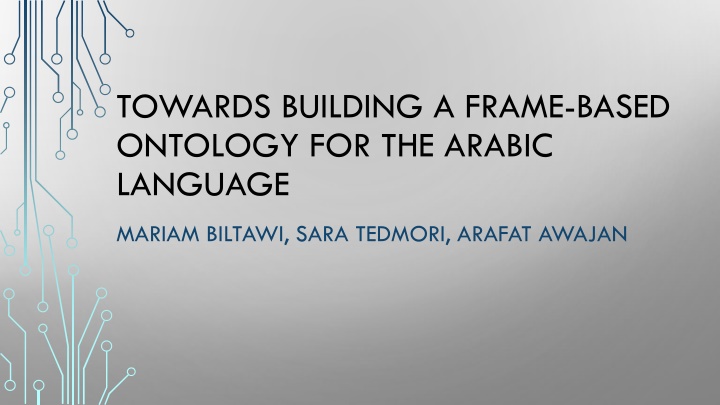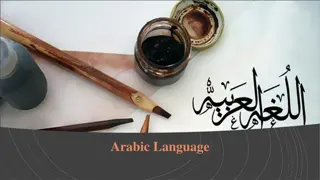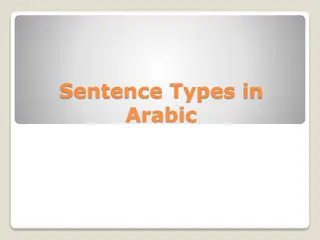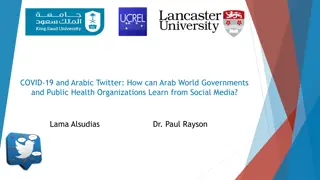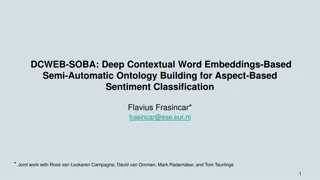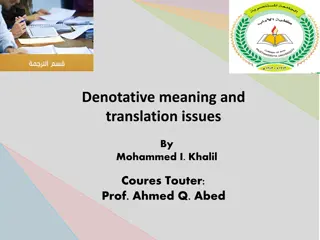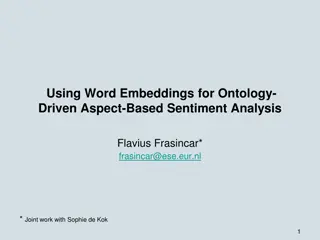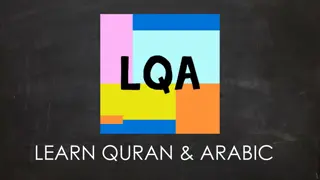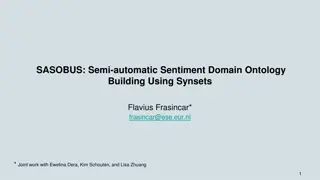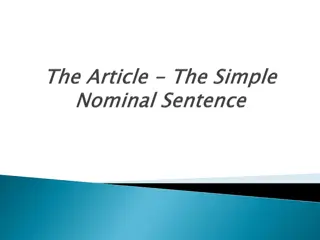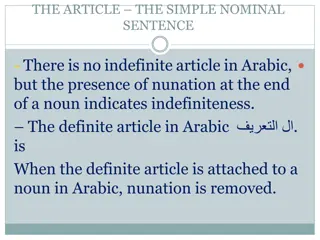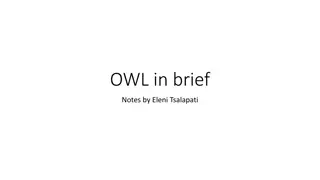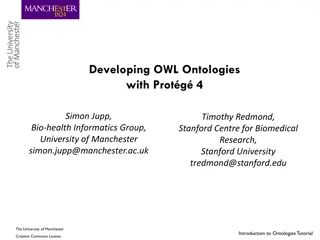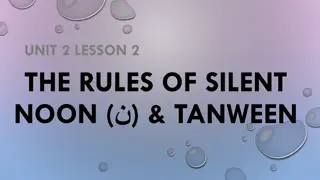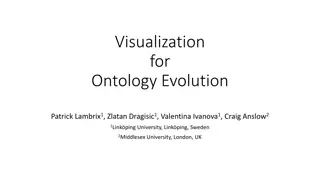Building a Frame-Based Ontology for Arabic Language
This project delves into constructing a frame-based ontology for the Arabic language, focusing on lexical semantics, related work, proposed framework, and conclusions. It explores the nuances of semantics at both word and sentence levels, covering aspects like synonyms, antonyms, hyponymy, and hierarchal relationships.
Download Presentation

Please find below an Image/Link to download the presentation.
The content on the website is provided AS IS for your information and personal use only. It may not be sold, licensed, or shared on other websites without obtaining consent from the author.If you encounter any issues during the download, it is possible that the publisher has removed the file from their server.
You are allowed to download the files provided on this website for personal or commercial use, subject to the condition that they are used lawfully. All files are the property of their respective owners.
The content on the website is provided AS IS for your information and personal use only. It may not be sold, licensed, or shared on other websites without obtaining consent from the author.
E N D
Presentation Transcript
TOWARDS BUILDING A FRAME-BASED ONTOLOGY FOR THE ARABIC LANGUAGE MARIAM BILTAWI, SARA TEDMORI, ARAFAT AWAJAN
AGENDA Introduction Part I: Lexical Semantics Part II: Related work Part III: Proposed Framework Conclusion
INTRODUCTION Natural Language Understanding NLU: is a subtask of Natural Language Processing NLU focuses on analyzing the semantic features present in a text such as concepts, entities, keywords, relations, emotions, categories and much more, with the anticipation of gaining a full understanding of the meaning conveyed in the text.
INTRODUCTION Semantics refer to the study of the meanings of words and phrases in language and can be applied to: Single words (aka lexical semantics): Entire texts (aka compositional semantics):
INTRODUCTION Lexical semantics are concerned with the meanings of individual words and with the meaning/semantic relationships that individual words have with one another. Compositional semantics are concerned with the meaning of the sentence or larger unit which goes beyond simply combining the meaning of the individual lexical words/units.
SYMMETRIC RELATIONSHIPS Synonyms refers to words that have different pronunciation but share the same meaning (e.g sit / ) Antonymy refers to word pairs sharing opposite meanings (e.g hot and cold / ).
HIERARCHAL RELATIONSHIPS Hyponymy refers to the relationship between a general word (aka hypernyms) and specific instances of it (aka hyponyms). For example, (cats and dogs / ) are hyponyms of the hypernym word (animals / ). Holonym refers to a word that denotes a whole of another word namely meronym which in turn is a part of the holonym. For example: the meronym ( / wheel) is a part of the holonym ( / car).
HOMONYMY Homographs refer to words that have different meanings but share the same spelling. Homophones refer to words that also have different meanings but are pronounced the same. Only examples of homographs can be found in the Arabic language as Arabic language is highly phonetic, i.e.: the writing reflects the pronunciation. For example, the word ( ) is a homograph word because it has two meanings either went or gold and one spelling.
EXAMPLE OF RESOURCES THAT PROVIDE BINARY LEXICAL RELATIONSHIPS BETWEEN WORDS WordNet for English Language. Arabic WordNet, a WordNet for Arabic language.
N-ARY RELATIONSHIPS Semantic fields is a set of words that have related meaning to specific object or namely a frame. These semantic fields represent n-ary relations with the frame that they refer to through capturing more relationships among entire sets of words from a single domain. Example: the words: University / , Lecturer / , Student / , Hall / , Library / , Lab / , Section / , Course / , Registration / , Are all related to the frame University Education / .
LEXICAL SEMANTICS Lexical semantics are realizable after successfully completing some/all of following subtasks: Word sense disambiguation, Semantic role labeling, Multiword expression composition/decomposition, Ontology learning and population, and Semantic language modelling.
ONTOLOGY Ontology is a technical term used to describe concepts, properties and relations among concepts in order to represent models of knowledge or discourse. It can represent meta-data schema for a knowledge of different applications in the form of vocabulary of concepts, and it can be shared by humans and machines.
ONTOLOGY Ontologies can be built either from unstructured text, or through exploiting directories of web documents, or through integrating existing resources. There are no research papers found that aims to build ontologies through integrating existing resources due to the lack of freely available resources.
RELATED WORK Although a number of attempts have been made to build ontologies for the Arabic language, only one resource, Arabic WordNet, which provides a lexical ontology for the Arabic language is freely available.
MAIN IDEA Is to provide machines with ontologies built from picture dictionaries, imitating the idea that children learn from such dictionaries in their early ages, and they are provided with the basic terms related to the world.
PROPOSED FRAMEWORK The proposed ontology learning and population framework consists of two main phases. Phase I: Manual Construction of the Frame-based Ontology. Phase II: Frame-based Ontology Population.
PHASE I: MANUAL CONSTRUCTION OF THE FRAME- BASED ONTOLOGY. Data collection 66 frames were collected from three English picture dictionaries each frame have multiple terms/semantic fields related to it.
PHASE I: MANUAL CONSTRUCTION OF THE FRAME- BASED ONTOLOGY. Data collection Grouping frames having relations with each other were grouped together to form one super frame
PHASE I: MANUAL CONSTRUCTION OF THE FRAME- BASED ONTOLOGY. Data collection Removing, adding and translating into Arabic Grouping the 66 frames with their related lexical fields will be translated and those fields that have unrelated meanings will be eliminated, while some other important fields will be added. cousin in the frame family represents different meanings in the Arabic language, a female or a male cousin either from the father s side or from the mother s side, therefore all these meanings need to be listed. part under the frame human head , is considered not an important word and has no significant translation into Arabic related frame human head .
PHASE I: MANUAL CONSTRUCTION OF THE FRAME- BASED ONTOLOGY. Data collection Removing, adding and translating into Arabic Grouping relations between these frames will be built manually in order to prepare the data in a hierarchal form which constitutes a frame and lexical fields below each frame, thus creating the frame-based ontology. Hierarchal preparation
PHASE I: MANUAL CONSTRUCTION OF THE FRAME- BASED ONTOLOGY.
PHASE II: FRAME-BASED ONTOLOGY POPULATION. Data collection Removing, adding and translating into Arabic Grouping Applied through looking up for each frame of the frame-based ontology in the WordNet. If a match is found, then all its related terms and relations will be brought and the ontology is populated. Hierarchal preparation Term lookup and enrichment The resulted ontology will represent a tree, where nodes represent frames and edges represents relationships.
PHASE II: FRAME-BASED ONTOLOGY POPULATION. For the frame Person / a number of senses will be brought from the WordNet. Such as ( where all of them could represent synonyms except ( ) which means soul, and can represent a part of person . The frame Person will be modified according to the new data received, noting that the replicated words will be neglected such as the senses (Person / , Human / ). ),
CONCLUSION AND FUTURE WORK A comprehensive introduction to lexical semantics was presented providing examples from the Arabic language. Related works of researchers aiming to build ontologies for the Arabic language was presented. The main objective was to propose a framework for building Arabic frame-based ontology. As a future work, an effort will be done to implement this work and conduct the experimental results.
